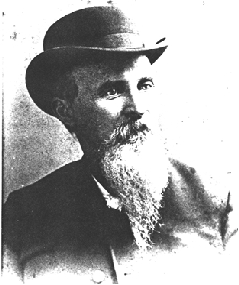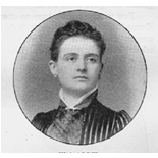
John Gately Downey was an Irish-American politician and the seventh governor of California from January 14, 1860, to January 10, 1862. He was the first governor of California born outside the United States and the first to live in Southern California.

Thomas More Storke was an American journalist, politician, postmaster, and publisher. He won the Pulitzer Prize in 1962. Storke also served as an interim United States Senator, appointed to serve between the resignation of William Gibbs McAdoo in November 1938 and the January 1939 swearing-in of Sheridan Downey, who had been elected to succeed McAdoo.
The Santa Barbara News-Press was a broadsheet newspaper based in Santa Barbara, California. It was founded in 1868 as the Post and merged with the rival News to form the News-Press in 1932. On July 21, 2023, it filed for bankruptcy and ceased publication.

For the writer see Frank S. Pixley

Charlotte E. Burton was an American silent film actress.

Alfred Shea Addis, also known as A.S. Addis, was an American Western itinerant photographer, mostly known for photographs of Kansas, Mexico, and the American Southwest.
Grant Jackson (1866–1925) was an attorney in Santa Barbara, California, and later a Los Angeles County Superior Court Judge, 1906–1915.
Charles Albert Storke was a prominent lawyer in 19th century California.
Buckhorn is a populated place name along State Route 126 in a rural unincorporated area of Ventura County, California, United States. Buckhorn is about 2 miles (3.2 km) outside the town of Piru but is within the eponymous census-designated place. Located in the Santa Clara River Valley, this was an early stagecoach stop and a regular eating place known for being midway between Los Angeles and Santa Barbara. It was run by the Warring family who came to the county in 1869 and owned the nearby Buckhorn Ranch. Buckhorn was also a station on the initial route of the coast rail line that arrived in the valley in 1887. With the completion of the Santa Susana Tunnel in 1904, the route through Oxnard and Simi Valley became the most direct route between Los Angeles and San Francisco. The shipping of agricultural products such as citrus continued to keep this route busy for many years. The Santa Paula Branch Line no longer connects through to Santa Clarita after the rails were washed out. The junction with the main line is near the East Ventura station.
Jack Powers, whose real name was John A. Power, was an Irish-born American outlaw who emigrated to New York as a child and later served as a volunteer soldier in the Mexican–American War in the garrison of Santa Barbara, California. During the California Gold Rush, he was a well-known professional gambler and a famed horseman in the gold camps as well as in San Francisco, Santa Barbara and Los Angeles.
Salomón María Simeon Pico was a Californio, a cousin of former governor Pío Pico, who led a bandit band in the early years following the Mexican–American War in the counties of the central coast of California. Pico was considered by some Californios to be a patriot who opposed the American conquest of Alta California and its subsequent incorporation into the United States. He was hated for his banditry by the newly arrived Americans but protected by some Californios as a defender of his people.
Rancho San Julian was a 48,222-acre (195.15 km2) Mexican land grant and present-day ranch in present-day Santa Barbara County, California given in 1837 by Governor Juan B. Alvarado to José de la Guerra y Noriega. The grant name probably refers to José Antonio Julian de la Guerra. The grant was located west of present-day Santa Barbara.
Rancho Pismo was a 8,839-acre (35.77 km2) Mexican land grant in present day San Luis Obispo County, California, given in 1840 by acting governor Manuel Jimeno Casarin to José Ortega. The grant extended along the Pacific coast and encompassed present day Pismo Beach, Grover Beach, Shell Beach and parts of Arroyo Grande.
Rancho Cañada de Salsipuedes was a 6,656-acre (26.94 km2) Mexican land grant in present-day Santa Barbara County, California given in 1844 by Governor Manuel Micheltorena to Pedro Cordero. Salsipuedes means "get out if you can", and the name refers to the narrow winding canyons and trails along Salsipuedes Creek. The grant was southeast of present-day Lompoc.
Rancho La Goleta was a 4,426-acre (17.91 km2) Mexican land grant in present-day Santa Barbara County, California given in 1846 by Governor Pío Pico to Daniel A. Hill. The grant extended along the Pacific coast from today’s Fairview Avenue in present-day Goleta, east to Hope Ranch. The grant was adjacent to Rancho Dos Pueblos granted to his son-in-law Nicolas A. Den in 1842.
Rancho Santa Ysabel was a 17,774-acre (7,193 ha) Mexican land grant in present-day San Luis Obispo County, California given in 1844 by Governor Manuel Micheltorena to Francisco Arce. The grant was southeast of present-day Paso Robles, between the Salinas River on the west and Huerhuero Creek on the east.
Rancho Santa Clara del Norte was a 13,989-acre (56.61 km2) Mexican land grant on the Oxnard Plain in present-day Ventura County, California. It was granted in 1837 by Governor Juan B. Alvarado to Juan María Sánchez.
La Patera was a historical locale in what is now the area of Goleta, California.
The Santa Maria Times is a daily American newspaper on California's Central Coast serving the cities of Santa Maria; Orcutt; Guadalupe; Nipomo; unincorporated parts of northern Santa Barbara County and southern San Luis Obispo County. It is published Tuesday through Saturday, and is part of Santa Maria California News Media Inc., which also publishes the Lompoc Record and Santa Ynez Valley News, among other newspapers.

Julia Frances Curry Williams (1826-1911) was one of the first female lighthouse keepers in California. She served for 40 years at the Santa Barbara Light from 1865 to 1905.






